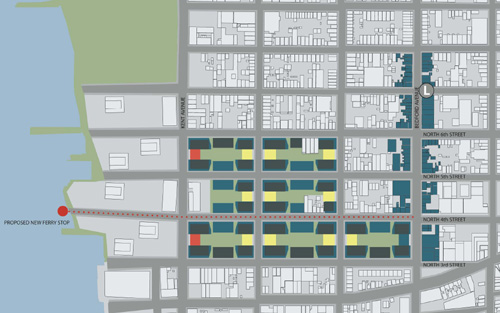Double Speak of the Week: Community Incentive Zoning

For our latest Double Speak of the Week, we turn to Williamsburg, where a politically-connected firm named Quadriad is trying to wrap its proposal to build 28 highrises on seven blocks with "Community Incentive Zoning."
We've previously delved quite a bit into Quadriad's plans, and this week, onNYTurf posted some eye-opening renderings of what buildings with the density the developer has discussed (after "community incentive zoning") could look like. The graphic above, taken from one of the developer's documents, shows the massive nature of the projects they're suggesting. (Whether the proposals are realistic or a bizarre political or PR ploy is another matter. If the intent was to capture attention, they've done it.)
We're not sure what "community incentive zoning" is in this context, other than an attempt to dress up "incentive zoning" with an extra word to make it sound more community-friendly. There is nothing new about "incentive zoning," a practice that has developers build certain amenities--such as parks and plazas--in return for a density bonus. The bonus, in turn, allows the developer to build more space than zoning allows and to make more money.
Incentive zoning is either a good or bad thing depending on one's point of view and on the project to which it's being applied or the purpose for which it's being use. In many communities, though, as the Era of Public Cheapness has progressed and the Public Policy School of Diminished Expectations has held sway, incentive zoning has been used to good effect. It's a tool for an age in which government throws up its hands and says to developers, "You build the damned park, and here's five extra floors on your building for your trouble."
The potential ugly side of incentive zoning or "community incentive zoning," if you will, shows itself in the Williamsburg proposal. Why? Because the developer treats the community like a remote Third World village, promising goodies like schools and day care centers in proportion to the extent to which they can build towers in a low-rise neighborhood. It's not hard to envision an early 20th Century European industrialist tracking down the village leader and promising four cartons of dirty French postcards and a case of Merlot in return for twice as much land for the itsy-bitsy strip mine that he wishes to excavate on village land.
Of course, the proposal puts it differently. "In exchange for reasonable upzoning for the building of other market-rate housing, the public facilities are built without city financial involvement," says the Quadriad proposal, which was written by Steven L. Newman of Baruch College at the City University of New York.
(IE: "So, you see, Mr. Leader, the village doesn't have to pay for the French postcards. We'll give them to you. Look at this one. Isn't she something? Just an extra five acres, Mr. Leader, and all four cartons are yours. And don't forget the case of Merlot, Mr. Leader. Whoopee juice and dirty postcards! Nobody will even notice the mine. Trust me.")
The "incentives" in the case of Williamsburg go as follows: For twice the allowable density, 25 percent of the housing will be affordable. For three times the allowable density, you get 25 percent affordable housing, another five percent of affordable housing, community retail space, community open space and land for a "key community facility." For four times the allowable density, you get everything above, plus land for "key community facilities" (plural), and the facility is built at no public cost.
The thinking behind this is that the community will find the incentives so appealing and hard to resist that they will work with the developer to push for the zoning changes. After all, what's a 30-story building on Bedford Avenue if it contains a community center?
For all these reasons, and so many more, "community incentive zoning" is GL's Double Speak of the Week.

0 Comments:
Post a Comment
<< Home